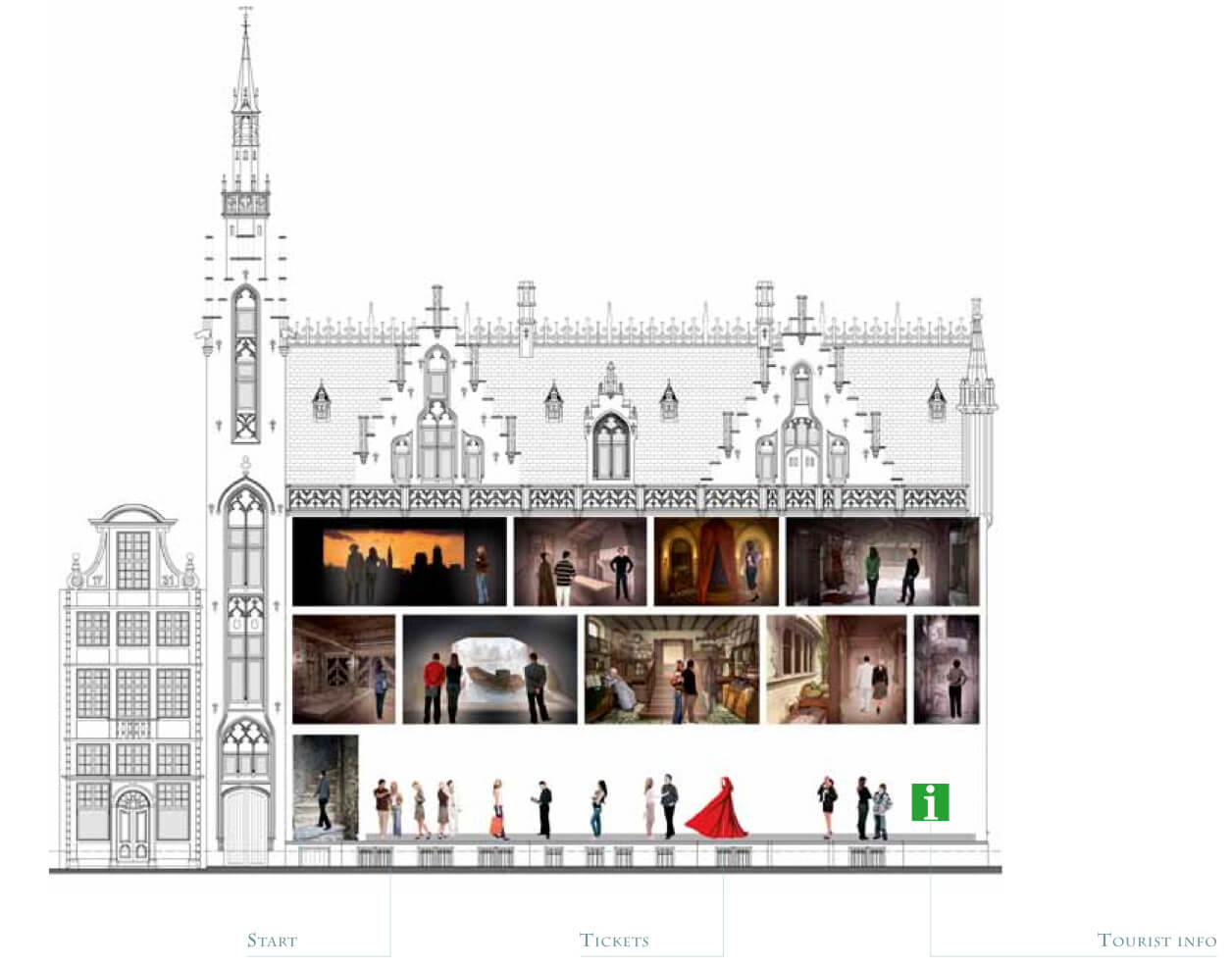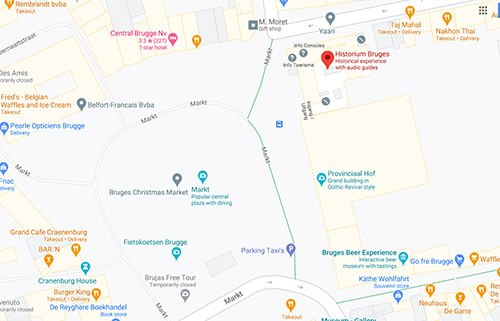
How it started
The Historium was begun by four West Flemish families. In 2006, the families Claeys and Denolf (Roularta), Vandamme (Barco) and Brackx (Jetair) got together to launch a tourist initiative, a project that would give Bruges added lustre and highlight their respective fields of expertise: communications, technology and tourism. Together with a historical committee, they developed a unique visitor attraction: a historical reconstruction in the form of a number of medieval scenes. At its launch the project received financial and logistical support from the Flemish Government, Tourism Flanders and the Province of West Flanders.
After several years of preparation, the renovation works on the building started at the end of 2011 and the film was shot in 2012. Meanwhile, the building has also been decorated, so the Historium officially opened on 25 November 2012.
In the first months and years, some changes were made to give visitors a better experience. For example, the number of languages for the audio guides was expanded, the aftershow became an interactive exhibition and extra elements were added to the attraction.
The first virtual steps were taken in 2015 and 2016 with the launch of the VR experience 'Historium Virtual Reality', the City VR (where visitors can view Bruges in 1435 with a cardboard and their smartphone in the city) and the Historium VR-app (to play at home with adapted VR glasses). What started as a small test quickly grew into a success, and extra VR cabs in the Historium could not be missed.
In 2017, the Historium was a finalist in the Toerisme Vlaanderen Awards in the category ‘Best Family-friendly Tourist Product’. Furthermore, we have also launched the Family Trail, which allows us to devote even more effort to activities and experiences for children and families.
In Summer 2018, we opened the LABORIUM Virtual Reality Gaming Arcade to the public. VR applications are tested here and visitors can play VR games, whether or not linked to the Historium. In addition, the first renovation works on the Historium Tower were started, and it was given a "soft opening" to the public.
Furthermore, the Historium was nominated as a laureate for Westtoers' Innovation & Creativity Prize 2018: a fantastic recognition of our work to inspire young people with new technology.
After all works were completed, the Historium Tower officially opened to the general public in early 2019. In addition, the Historium also received the quality label Q-label from Westtoer.
Several projects were again completed in the first months of 2021: the renewal and extension of the Duvelorium Grand Beer Café, an extension of the Historium Exhibition and the relocation of the Tourist Information Point. The Laborium reopened in the summer as VR Arcade Brugge.
Location
The Historium has an ideal location in the heart of the city. This was formerly the site of the Waterhalle, an important building in the history of Bruges. That building now plays an important role in the Historium attraction. It has been completely reconstructed in the Historium Story and the Historium Virtual Reality.
Fun facts
- In total 43 actors and extras participated in the filmed section of Historium Brugge.
- The screenplay was written by Gerrie Van Rompaey, together with Nicholas Lens and Kene Illegems.
- The sets took nine weeks to construct.
- Filming was done in three different studios of Alfacam in Lint.
- On the first day of shooting, the crews filmed for 20 hours.
- On the first day of shooting, the two babies peed on Anna’s cape eight times altogether.
- Some 200 m² of cobblestones were used in the harbour scene set.
- The harbour scene set was built in Belgium’s largest blue key studio (800 m² in area and 8 metres high).
- The director was the famous Caviar director Kene Illegems.
- The director of photography was Toon Illegems, the father of Kene Illegems.
- The cast’s rented costumes were imported from London and Madrid.
- The costumes were designed by Charlotte Willems, a Flemish designer known, among other things, for her costume designs for the popular TV series ‘De smaak van de Keyser’. Anna’s cape was designed by Kaat Tilley and made by Kunstateliers Slabbinck of Bruges.
- It took three people three days to decorate Anna’s cape with pearls.
- The props were rented in London.
- The rose-ringed parakeet ‘Happy’, who plays an important role in the Historium narrative, wandered freely around the studios in search of human contact. If he was put in a cage, he tried to break out. There was also a stand-by rose-ringed parakeet, in case of emergencies.
- The music was written by Nicholas Lens and played by the Brussels Philharmonic, conducted by Dirk Brossé. The songs you hear are from the Vlaams Radio Koor.
- The music recordings took place in Flagey's Studio 4.
- The historical research for the realization of the Historium was done by a historical committee with em. prof. dr. Wim Blockmans, dr. Noël Geirnaert and dr. André Vandewalle. Special thanks go to Kristel Van Audenaeren (Musea Brugge) and Hannes Dendooven.
Cast
- Anna - Clara Cleymans
- Jacob - Lander Gyselinck
- Jan van Eyck - Leslie De Gruyter
- Piero Di Bicci - Michel Van Dosselaere
- Wieland Lauweryn - Peter Van Den Begin
- Pijnder - Marc Peeters
- Carrier - Norman Baert
- Clerk 1 - Peter De Graef
- Clerk 2 - Danny Louncke
- Rosemary - Ana Cristina Velasquez
- Lucia - Noor Ben Taouet
- Willem - Milton Boon
- Servant girl - Maike Beckers
- Naked girl - Joy Anna Thielemans

